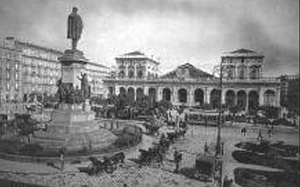The Station
With approximately 137,000 daily users and 50 million annually, Napoli Centrale is a vital interchange hub for the entire national railway system. It welcomes 390 trains each day.
The railway hub includes, in addition to the surface station (Napoli Centrale), an underground station (Piazza Garibaldi), with two tracks dedicated to the metro service and two belonging to the FS network. Additionally, beneath Corso Lucci, there is the station for the "Circumvesuviana" railway line.
History

The first Naples station was built in 1866, based on a design by architect and urban planner Enrico Alvino, who determined its layout and location as part of an urban planning study for the reorganization of the city's road network.
With the gradual increase in traffic over the years, it became necessary to revise the station’s layout and allocate larger spaces for circulation in the surrounding area.
Therefore, between 1954 and 1960, the 19th-century station was demolished and a new passenger building was constructed, set back 250 meters from its original location. The project also included the creation of the current Piazza Garibaldi.
The new building, inaugurated in 1966, is the result of the merger of the three winning designs from the competition announced in 1954. The complex features a canopy structure, characterized by a geometric modulation based on a triangular compositional matrix.
Redevelopment

The renovation and enhancement of the station focused on architectural, plant engineering, and functional aspects. The reorganization of internal pedestrian routes was carried out alongside the development of areas designed to host a wide and diverse range of high-quality railway, commercial, and dining services, dedicated to both travelers and the city as a whole.
To improve internal mobility within the station and to eliminate architectural barriers, five elevators were installed, connecting the various station levels. A new public information system (comprising both fixed and dynamic signage) was implemented. Additionally, two new stairways were built to provide external access to the station, and all existing stairways were renovated. In total, eleven new escalators were installed.
Security
At Napoli Centrale Station, a control room is operational to ensure continuous monitoring of the station through surveillance services and supervision of security systems.
In addition, a security service is in place to oversee the areas, detect and report non-compliance issues, and carry out security interventions. This service is also responsible for emergency management and, together with the maintenance staff, provides first response actions and support to external rescue teams.
To support and optimize human resources, several security systems have been installed throughout the station, including:
Surveillance and digital video recording systems;
Access control and intrusion detection systems;
Fire detection systems.
The system, as described, is closely coordinated with the Railway Police to ensure the immediate escalation and management of any critical situations.
Station Services
- Travel Agency
- BanK
- ATM
- Barber
- Currency Exchange
- Luggage Deposit
- Freccia Club
- Information
- Lounge Italo Club
- Rental Car
- Lost and Found
- Railway Police
- Sala Blu - Assistance
- Restrooms
- Shopping